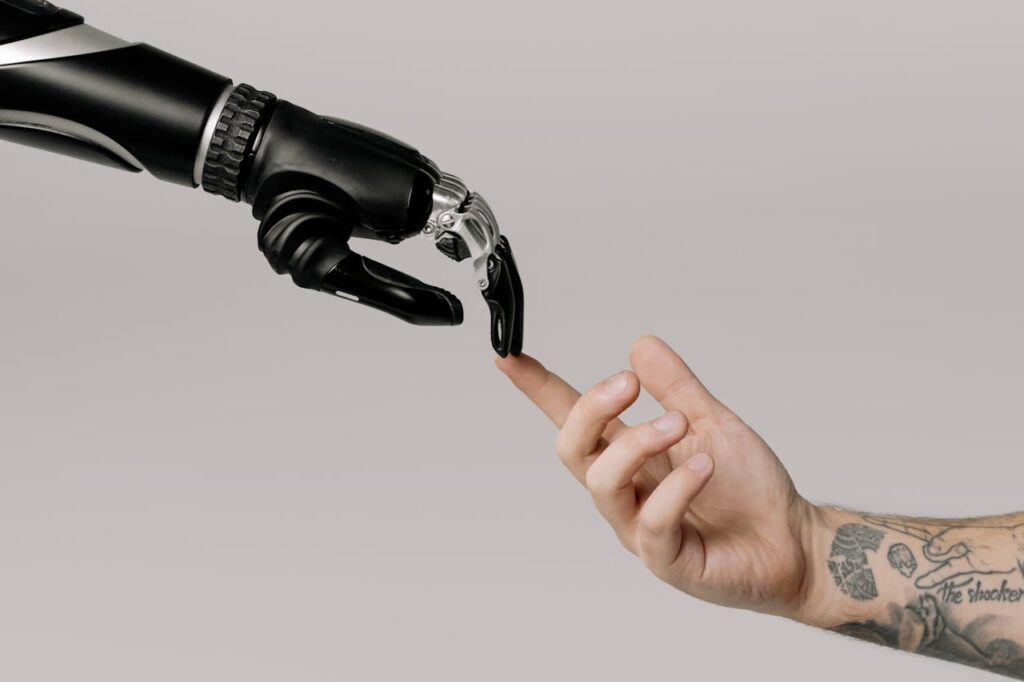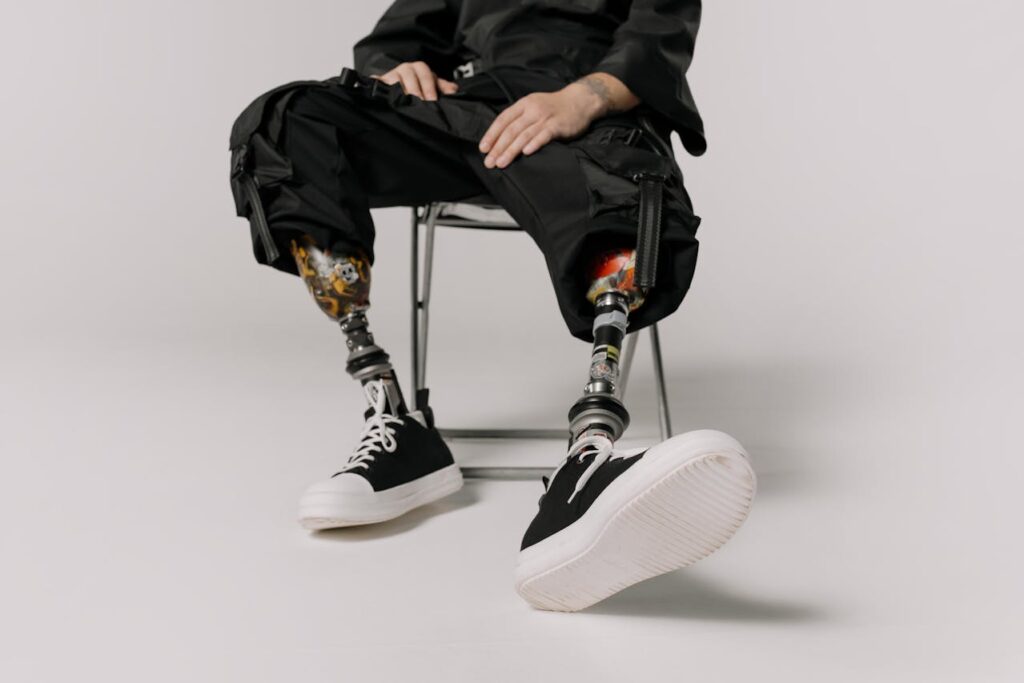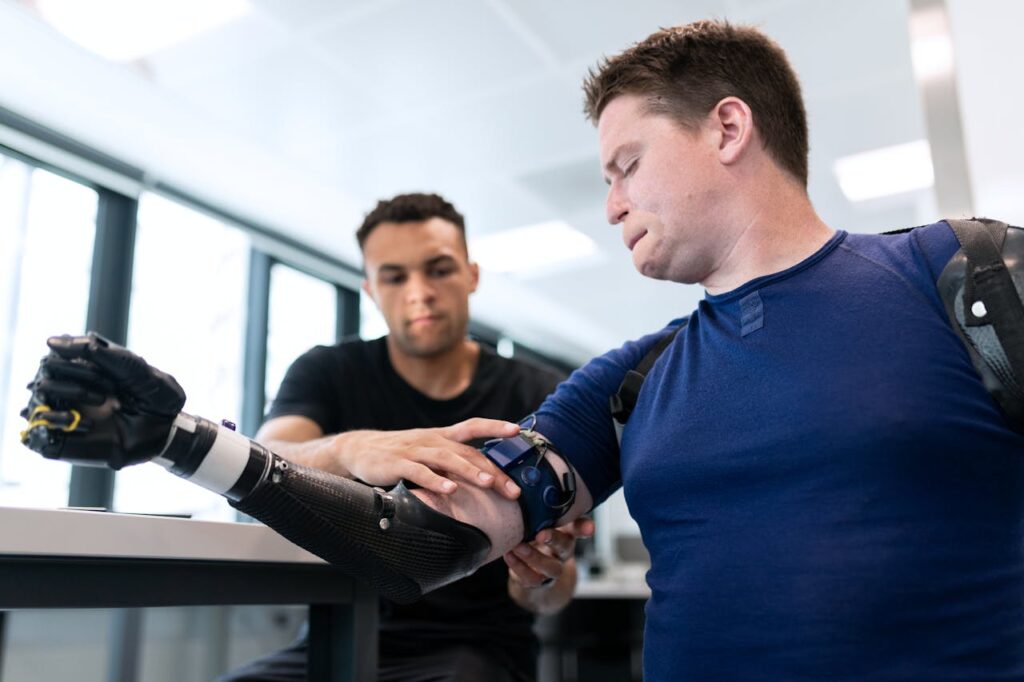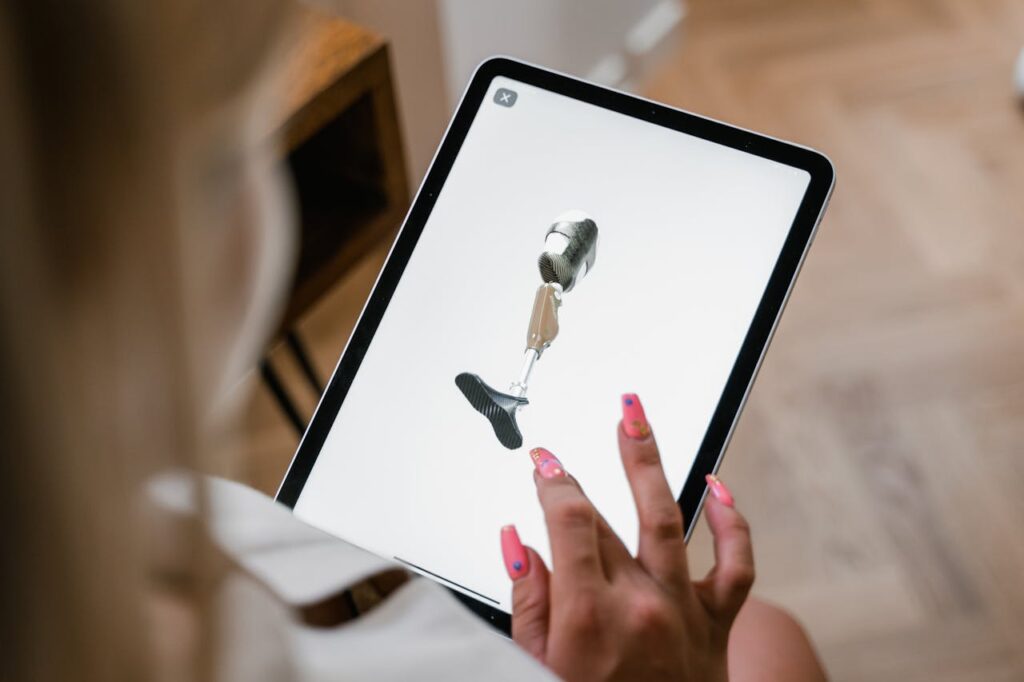Prosthetics have come a long way in restoring movement and function, but for many users, the missing link has always been the sense of touch. Without it, even the most advanced prosthetics can feel disconnected, leaving users aware of the divide between their body and the device. This is where haptics is changing the game.
Haptics, the technology that replicates the sensations of touch, is transforming prosthetic design. By enabling users to feel pressure, texture, and even temperature, haptic-enabled prosthetics are bridging the gap between technology and the human body. These advancements are not just technical milestones—they are creating profound emotional connections, giving prosthetics a level of humanity never seen before.
Rebuilding Emotional Connections Through Haptics
The ability to feel is deeply tied to how we connect with the world and the people around us. Traditional prosthetics, while revolutionary in their mechanical capabilities, often leave users feeling detached.
Without tactile feedback, actions like shaking hands, holding a child, or touching a loved one lack the sensory connection that makes these experiences meaningful.
Restoring Intimacy and Everyday Joys
Haptic-enabled prosthetics provide users with the ability to experience the subtle joys of touch, from the warmth of a loved one’s hand to the softness of a favorite fabric. These seemingly simple sensations are critical for restoring intimacy and reinforcing bonds that may have been affected by the absence of touch.
For example, a user with a haptic-enabled hand prosthetic can once again experience the satisfaction of holding their child’s hand or hugging a family member.
These moments carry immense emotional weight, helping users feel whole and connected to their loved ones. Businesses can highlight these emotional benefits in their messaging, focusing on how haptics enables users to reclaim these precious experiences.
To enhance this connection further, companies can invest in fine-tuning the sensitivity of haptic feedback. The more realistic and nuanced the sensations, the closer the prosthetic comes to replicating natural touch, deepening the emotional impact for the user.
Building Confidence Through Sensory Integration
The absence of tactile feedback in traditional prosthetics often makes users hesitant to engage fully in social or professional environments. They may avoid certain tasks or interactions for fear of mistakes, such as dropping an object or applying too much pressure.
Haptic feedback eliminates this uncertainty by providing real-time sensory cues, enabling users to trust their prosthetic as they would a natural limb.

This trust is transformative. As users gain confidence in their prosthetic’s capabilities, they are more likely to participate in activities that they might have avoided previously, from cooking meals to participating in group sports.
Businesses can capitalize on this by designing prosthetics that emphasize reliability and intuitive sensory integration, helping users feel empowered and self-assured.
Empowering Self-Expression
Haptics also plays a role in self-expression by allowing users to interact with their environment in ways that feel natural and authentic. A musician with a haptic-enabled prosthetic, for instance, can feel the vibrations of their instrument, enabling them to connect more deeply with their craft.
Similarly, an artist can experience the texture of their medium, enhancing their creative expression.
For businesses, supporting self-expression through haptics offers an opportunity to engage with niche markets such as artists, athletes, or professionals in specialized fields.
By tailoring haptic feedback to the specific needs of these users, companies can create products that cater to their passions, making the prosthetic a tool for creativity and individuality.
Creating Moments of Normalcy
The emotional impact of haptics often lies in its ability to create moments of normalcy. Tasks that once felt robotic or disconnected suddenly become fluid and intuitive, allowing users to focus on the experience rather than the mechanics of their prosthetic.
For example, a user preparing a meal with a haptic-enabled hand can feel the texture of vegetables as they chop them, allowing for better control and an experience closer to cooking with a natural hand. These moments, while seemingly mundane, are powerful in their ability to restore a sense of everyday normalcy.
Businesses can leverage these stories in their branding, demonstrating how haptics helps users re-engage with life’s simple pleasures.
Campaigns that showcase real-life scenarios where haptic prosthetics enhance normal activities can create an emotional connection with potential users and their families.
Supporting Psychological Resilience
The psychological benefits of haptics go beyond the immediate experience of touch. For many users, the ability to feel through their prosthetic helps reduce the sense of loss associated with amputation.
It becomes a bridge between who they were before and who they are now, fostering acceptance and resilience.
Businesses can play a pivotal role in supporting this transition by emphasizing the emotional journey of users in their product development and communication strategies.
Offering counseling resources, support networks, or peer mentorship programs alongside haptic-enabled prosthetics can create a holistic user experience that addresses both physical and emotional needs.
Strategic Considerations for Businesses
To maximize the impact of haptics in rebuilding emotional connections, businesses should prioritize collaboration and innovation. Partnering with psychologists, occupational therapists, and user communities can provide valuable insights into the emotional needs of prosthetic users.
These partnerships can inform design choices, ensuring that haptic feedback aligns with the diverse experiences and expectations of users.

The Technological Foundations of Haptic Prosthetics
Creating a prosthetic device with haptic capabilities requires a sophisticated combination of sensors, actuators, and software. Each component plays a critical role in delivering realistic feedback, ensuring the device is both functional and intuitive.
Collaborative Innovation for Cutting-Edge Solutions
Developing haptic prosthetics that feel natural and intuitive requires expertise across multiple domains, including engineering, neuroscience, material science, and software development.
By forming partnerships with academic institutions, technology firms, and research organizations, businesses can leverage specialized knowledge and access the latest advancements in these fields.
For instance, collaborating with universities conducting research on neural integration can provide insights into more seamless communication between prosthetics and the human nervous system.
Joint projects with AI developers can lead to smarter, more responsive haptic systems that adapt to user behavior in real time. These collaborations not only enhance product innovation but also strengthen the brand’s reputation as a pioneer in prosthetic technology.
Building a Global Ecosystem
Haptics in prosthetics is a global challenge, with diverse needs and opportunities across regions. Businesses can create a global ecosystem by forming partnerships with local organizations, governments, and healthcare providers.
This approach ensures that haptic prosthetics are tailored to the cultural, economic, and environmental contexts of the regions they serve.
For example, working with healthcare providers in low-resource areas can help businesses design prosthetics that prioritize durability and simplicity while maintaining advanced haptic functionality.
Partnering with government agencies to create subsidy programs or regulatory pathways can streamline product deployment and reduce costs for end-users.
These collaborations create a win-win scenario: businesses expand their reach, and communities gain access to life-changing technology.
Engaging the User Community
The users of haptic prosthetics are the most valuable partners in the development process. Their lived experiences, feedback, and suggestions are critical for creating devices that truly meet their needs. Businesses should prioritize user engagement through focus groups, beta testing programs, and interactive workshops.
By actively involving users in the design process, companies can identify pain points, uncover unmet needs, and refine their products to deliver a better experience.
For instance, users might provide insights into how haptic feedback could be more intuitive or which tasks require enhanced tactile sensitivity. Incorporating this feedback ensures that the final product resonates with its intended audience.
Furthermore, creating online communities where users can share their experiences, connect with peers, and interact with the company fosters a sense of belonging and trust.
These communities can also serve as a valuable source of testimonials and stories that businesses can use to showcase the real-world impact of their prosthetics.
Expanding Access Through Strategic Partnerships
Accessibility remains one of the biggest challenges in the adoption of haptic prosthetics. High production costs and limited distribution networks can make these devices inaccessible to many potential users. Businesses can address this challenge by forming partnerships that lower costs and expand reach.
Collaborations with NGOs and charitable organizations can help subsidize the cost of prosthetics for underserved populations. Manufacturing partnerships can optimize production processes to reduce expenses without compromising quality.
Additionally, businesses can explore licensing agreements with local manufacturers to produce and distribute haptic prosthetics in specific regions, ensuring that the technology reaches users in need.

Haptics and Enhanced Functional Capabilities
Haptics doesn’t just add a sense of touch to prosthetics—it enhances their overall functionality. By providing sensory feedback, haptic-enabled prosthetics allow users to perform tasks with greater precision and control, improving their ability to engage in everyday activities. This enhanced functionality can be life-changing, empowering users to regain independence and confidence in their abilities.
Grip Control and Object Handling
One of the most significant challenges with traditional prosthetics is controlling grip strength. Without feedback, users may apply too much force and damage delicate objects or fail to grip securely enough and drop them.
Haptics solves this problem by delivering real-time sensory cues, enabling users to adjust their grip based on what they feel.
For example, haptic sensors in a prosthetic hand can detect the firmness of an object and provide proportional feedback to the user. This lets them modulate their grip, ensuring they can handle a range of objects—from holding a pen to carrying a heavy bag—with confidence and ease.
Navigating Diverse Environments
For lower-limb prosthetic users, haptics provides crucial feedback about the terrain underfoot. Sensors in the prosthetic foot detect surface variations, such as gravel, grass, or uneven ground, and relay this information through actuators.
This feedback helps users adjust their balance and walking style, making movement safer and more intuitive.
For businesses, incorporating haptic feedback into lower-limb prosthetics is a strategic opportunity to serve users who lead active lifestyles or navigate challenging environments.
Highlighting this feature as a key benefit can position the product as a premium offering tailored to adventurous and independent users.
Challenges in Implementing Haptics in Prosthetics
While haptics is revolutionizing prosthetic design, its integration comes with significant challenges that businesses must address to deliver effective solutions. These challenges are not just technical but also practical, encompassing user adoption, affordability, and accessibility.
Cost and Affordability
Haptic technology involves advanced components like high-precision sensors, actuators, and complex algorithms, making it more expensive than traditional prosthetics. For many users, especially in developing countries, cost can be a barrier to accessing these cutting-edge devices.
Businesses can tackle this challenge by exploring cost-efficient manufacturing techniques such as 3D printing, which reduces production costs without compromising quality.
Offering modular designs that allow users to add haptic features as upgrades can also make the technology more accessible to a broader audience. Collaborations with NGOs and government programs to subsidize costs can further enhance affordability.
Power and Battery Life
Haptic prosthetics require power to operate their sensors and actuators, which can drain batteries quickly. Users often face the inconvenience of frequent recharging, particularly when using their prosthetics for extended periods.
Investing in energy-efficient designs and advanced battery technologies is crucial to overcoming this challenge.
Lightweight batteries with longer life spans or prosthetics that incorporate energy-harvesting mechanisms, such as generating power through movement, can improve the user experience and extend usability.

The Future of Haptics in Prosthetics
Haptics is still in its early stages, but its potential to transform prosthetics is undeniable. As the technology evolves, it will not only become more accessible but also more sophisticated, offering new possibilities for users and businesses alike.
Expanding Sensory Feedback
Future advancements in haptics aim to expand the range of sensations prosthetics can replicate. Researchers are exploring ways to integrate temperature sensitivity, allowing users to feel warmth or cold through their prosthetics.
This development would further enhance the realism and functionality of artificial limbs, creating a more seamless connection between the user and their environment.
For businesses, investing in research and development to incorporate these advanced features can position them as leaders in the field. Collaborating with academic institutions and technology companies can accelerate innovation while ensuring that new solutions are practical and user-friendly.
Neural Integration
The ultimate goal for haptics in prosthetics is full neural integration, where the prosthetic communicates directly with the user’s nervous system. This would allow for more precise control and feedback, making the prosthetic feel like a true extension of the body.
Emerging technologies, such as brain-computer interfaces (BCIs) and nerve-stimulation techniques, are paving the way for this breakthrough. While still experimental, these approaches hold immense promise for the future of prosthetic design.
Businesses that actively engage in these cutting-edge developments will be well-positioned to offer next-generation solutions to their users.
How Businesses Can Leverage Haptics
For prosthetic manufacturers, haptics is not just a technological advancement—it is a strategic opportunity to redefine the industry and deliver unparalleled value to users. By adopting a user-centered approach and addressing key challenges, businesses can establish themselves as leaders in this transformative field.
Prioritizing User Education
Haptics introduces a new level of complexity to prosthetics, and users may need time to adapt to the feedback. Providing comprehensive training and support ensures that users can fully benefit from the technology.
Educational resources, such as tutorials, workshops, and virtual guides, can empower users to understand how their prosthetic works and how to interpret haptic feedback effectively.
Businesses that invest in user education not only enhance satisfaction but also build trust and loyalty among their customers.

Building a Community
Haptic-enabled prosthetics are more than individual devices—they represent a growing movement toward innovation and inclusion. Businesses can foster this movement by creating communities where users can share their experiences, provide feedback, and connect with others.
Online forums, social media groups, and events can help users feel supported and valued, while also offering businesses valuable insights into user needs and preferences.
This feedback loop drives continuous improvement and strengthens the relationship between the brand and its users.
Bridging Accessibility Gaps in Haptic Prosthetics
One of the most pressing challenges in bringing haptic prosthetics to market is ensuring they are accessible to all users, regardless of socioeconomic background or geographical location. While the technology is groundbreaking, its benefits will only be fully realized when it becomes available to a diverse range of users. Businesses have a vital role to play in making this vision a reality.
Scaling Affordability Through Innovation
The integration of haptics into prosthetics currently involves high production costs, driven by the use of advanced sensors, actuators, and microprocessors. For businesses, addressing this economic barrier requires innovative manufacturing methods that reduce costs without sacrificing quality.
Adopting scalable production techniques like 3D printing can significantly lower the expense of creating customized components. Additionally, exploring open-source platforms for basic haptic algorithms can democratize access to foundational technology, allowing businesses to allocate resources toward developing unique features or enhancing user experience.
Creating tiered product offerings is another effective strategy. Entry-level haptic prosthetics can focus on delivering essential feedback like pressure or grip force, while premium models can offer advanced features such as temperature sensitivity or neural integration.
This approach ensures that a wider audience can access the technology while maintaining opportunities for premium sales.
Partnering with Local Communities
Localization is a powerful way to enhance accessibility while also creating cultural resonance. By establishing partnerships with local organizations, artisans, and healthcare providers, businesses can ensure that their haptic prosthetics address specific community needs.
For example, in rural areas where resources are limited, prosthetic designs that use locally sourced materials or modular components for easy maintenance can make haptic technology more practical and affordable. Training local technicians to provide repairs or adjustments further supports long-term usability, reducing reliance on external resources.
Additionally, businesses can collaborate with NGOs and government initiatives to subsidize the cost of haptic prosthetics for underserved populations. These partnerships not only expand access but also enhance the company’s reputation for social responsibility and innovation.
The Role of User-Centered Design in Haptics
Haptics has the potential to revolutionize prosthetics, but its success hinges on how well it aligns with user needs and preferences. A user-centered design approach is essential for ensuring that the technology enhances both functionality and emotional connection.
Customization for Individual Needs
Every user has unique preferences and requirements, particularly when it comes to sensory feedback. Some users may prefer subtle vibrations to indicate grip pressure, while others may benefit from more pronounced feedback for complex tasks.
Businesses can address this diversity by incorporating adjustable settings into their prosthetic designs.
For example, a smartphone app that connects to the prosthetic could allow users to customize haptic intensity, frequency, or even specific feedback patterns for different activities.
This level of personalization empowers users to adapt their prosthetic to their lifestyle, increasing satisfaction and usability.
Continuous Feedback and Iteration
Developing haptic prosthetics is not a one-time effort—it requires ongoing refinement based on user experiences and technological advancements. Businesses can establish channels for continuous feedback, such as surveys, focus groups, or user-testing programs.
This iterative process not only improves the product but also fosters a sense of collaboration between the company and its users. When customers feel their voices are heard, they are more likely to trust and advocate for the brand, creating a strong foundation for long-term success.
The Societal Impact of Haptic Prosthetics
Beyond individual users, haptic prosthetics have the potential to influence societal perceptions of disability and technology. By normalizing advanced prosthetics that offer sensory feedback, businesses can contribute to a broader shift toward inclusivity and innovation.
Changing the Narrative Around Disability
Haptic prosthetics challenge outdated stereotypes by demonstrating that disability does not have to mean limitation. By offering users tools that restore not just function but sensation, these devices redefine what is possible.
Marketing campaigns that celebrate the achievements of users with haptic prosthetics can amplify this message, inspiring others and reducing stigma.
Featuring real stories of individuals who have regained independence or achieved extraordinary feats with the help of haptics highlights the transformative power of this technology.

Driving Innovation Across Industries
The advancements made in haptics for prosthetics have implications far beyond this field. Innovations in tactile feedback, neural interfaces, and material science can influence sectors like robotics, virtual reality, and wearable technology.
Businesses that invest in haptic prosthetics are not just shaping the future of mobility—they are contributing to a larger ecosystem of innovation.
Partnering for Progress
To fully realize the potential of haptics in prosthetics, collaboration across industries and disciplines is essential. Businesses, research institutions, healthcare providers, and government agencies all have a role to play in advancing this transformative technology.
Investing in Research and Development
Continued investment in research and development is critical for pushing the boundaries of what haptic prosthetics can achieve.
Businesses can collaborate with academic institutions and technology companies to explore new materials, improve sensor accuracy, and develop more efficient algorithms.
These partnerships not only accelerate innovation but also share the financial burden of R&D, making cutting-edge solutions more feasible.
Expanding Awareness and Accessibility
Raising awareness about the benefits of haptic prosthetics is key to driving adoption. Businesses can work with healthcare providers to educate users about how haptics can enhance their quality of life.
Demonstrating the technology at conferences, workshops, or community events can also generate excitement and interest among potential users.
Ensuring that haptic prosthetics are accessible to underserved populations is equally important. Collaborating with government agencies to create subsidy programs or partnering with nonprofits to distribute devices can expand access and establish the company as a socially responsible leader in the field.
Conclusion
Haptic technology is revolutionizing the world of prosthetics, turning devices once focused solely on functionality into humanlike extensions that restore not just movement but also the sense of touch.
This transformation goes beyond physical sensations—it reconnects users to their environment, empowers them with confidence, and fosters emotional resilience.
For businesses, haptics represents a unique opportunity to lead in innovation and inclusivity. By investing in research, collaborating across disciplines, and prioritizing accessibility, companies can deliver life-changing solutions to users worldwide.
The journey is about more than creating advanced devices; it’s about making prosthetics that feel human and deeply personal, offering dignity and empowerment to those who use them.



